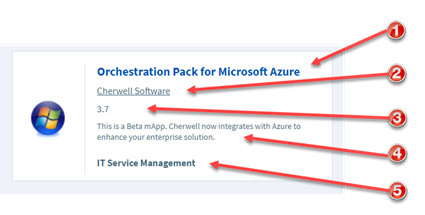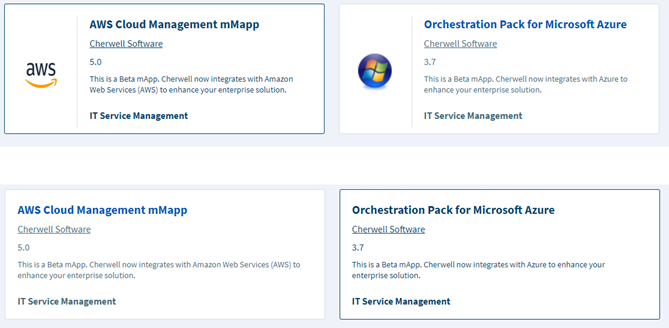Define Display Properties for an Action Catalog Widget
Use the Display page (accessed from within the Action Catalog Widget Properties window) to define the display properties for an Action Catalog Widget.
- How the Action Catalog Widgets will display: Style, color, text, images, etc.
- When the Actions will happen: Use an
Expression to
enable or disable Actions using an Expression (example: Disable Actions for
Users in a specific Security Role).
Note: The Action Catalog Properties window is accessed from within the Widget Manager when you create or edit an Action Catalog Widget.
To define display properties for an Action Catalog Widget:
OOTB: The OOTB Service Catalog uses the Metro Blue theme to display Actions in colorful tiles. The text to display in the Action hyperlink (example: One-Time Conference Setup and Request Account) comes from the Subcategory Field. No description or images are used, and no Expressions are used to enable/disable Actions.
- Create a Widget.
- In the Type drop-down, select Action Catalog.
- Select a
Style (color, font, etc.) for the Action
Catalog. Styles vary by layout (ex: Column, List, Cards with Search).
Note: Styles are based on Cascading Style Sheets (CSS) and can vary the functionality of the Action Catalog (example: The Metro style can display only three levels in a hierarchy).
- Select a Theme for the Action Catalog. Themes vary by color (ex: A/C Forest, A/C Orange, Earth Tones).
- If you select the Style Cards with Search, you can optionally select the check box for Always show items as cards.
- In
Fields Holding Display Text, select the text to
display in the Action hyperlink:
- (Mandatory)Title text: Select the Field to provide the text that displays in the hyperlink (example: Subcategory).
- (Mandatory) Descriptive text: Select the Field to provide a description of the Action. The descriptive text displays directly under the hyperlink.
Note: If you select Always show items as cards, you can then select text for these extra fields: Subtitle, Rating and Footer. These three fields are text fields and Rating has no search ranking calculations associated with it. Consequently, you can use these fields for any values that your company wants to display in your Action Catalog cards. This figure shows an example of all 5 text fields in use:1. Title text
2. Subtitle
3. Rating
4. Description
5. Footer

- (Optional) Select the images to display next to the Action
hyperlinks:
- Show image next to each command: Select
this check box to display an image next to each Action hyperlink and then
select the images, either:
- Field with image: Select this radio button to display an image from a Field, and then select the Field that contains the image from the list.
- Expression: Select this radio button
to use an
Expression to conditionally
provide the image (example: If Subcategory equals Submit Incident, display a
green check mark), and then define the Expression using one of the following
options:
- Stored Expression: Click the
Ellipses button
 to open the Expression Manager, and then
select an existing stored Expression or
create a new stored
Expression. Stored Expressions can be reused in numerous places in
CSM.
to open the Expression Manager, and then
select an existing stored Expression or
create a new stored
Expression. Stored Expressions can be reused in numerous places in
CSM.
- Custom Expression: Click the
Custom Expression button
 to open the Custom Expression Builder, and
then create a custom Expression specifically for this scenario.
to open the Custom Expression Builder, and
then create a custom Expression specifically for this scenario.
- Stored Expression: Click the
Ellipses button
The figure below shows two Cards with Show image next to each command selected at the top and not selected at the bottom.

- Show image next to each command: Select
this check box to display an image next to each Action hyperlink and then
select the images, either:
- (Optional) Select the check box
Use an expression to enable/disable actions to
use one of the following options (example: To Disable Actions for Users in a
specific Security Role):
- Stored Expression: Click the
Ellipses button
 to open the Expression Manager, and then select an
existing stored Expression or
create
a new stored Expression. Stored Expressions can be reused in numerous places in
CSM.
to open the Expression Manager, and then select an
existing stored Expression or
create
a new stored Expression. Stored Expressions can be reused in numerous places in
CSM.
- Custom Expression: Click the
Custom Expression button
 to open the Custom Expression Builder, and then
create a custom Expression specifically for this scenario.
to open the Custom Expression Builder, and then
create a custom Expression specifically for this scenario.
- Stored Expression: Click the
Ellipses button
-
Select OK.